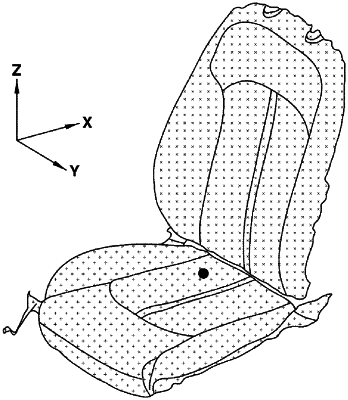| CPC G01B 21/20 (2013.01) | 8 Claims |

|
1. A system for automatically checking seat dimension accuracy for a vehicle, the system comprising:
a memory unit configured to store therein seat design data at a time of designing an actually produced seat and seat scan data obtained by scanning the actually produced seat;
a controller configured to determine when the actually produced seat has been produced to match predesigned dimensions using the seat design data and the seat scan data stored in the memory unit and to convert the seat design data and the seat scan data into a three-dimensional seat shape and to automatically measure reference points and dimension values while superimposed on each other to compare difference values therebetween; and
a display unit configured to output a result of determination by the controller in a predetermined form;
a scanner configured to scan the actually produced seat and to generate the seat scan data;
an external device configured to provide the seat design data at a time of designing the actually produced seat; and
a communication part configured to transmit the seat scan data generated by the scanner and the seat design data provided by the external device to the memory unit,
wherein the controller includes:
an input loading part configured to load the seat design data and the seat scan data stored in the storage unit to display the stored data, and including predetermined information input windows and menus for seat matching;
a seat matching part configured to compare dimensions and shapes of the seat design data and the seat scan data with each other or to make the dimensions and shapes of the seat design data and the seat scan data overlap each other and dividing the seat model in accordance with the seat scan data into a seat cushion and a seat back, and analogizing a rotation axis of the divided seat after the seat model is divided into the seat cushion and the seat back in accordance with the seat scan data;
a measurement part configured to determine the reference points for a cutting plane in a state in which the seat design data and the seat scan data overlap each other of a selected section, and automatically measure the dimension values of the seat design data and the seat scan data on a predetermined section cutting plane in a state in which the seat design data and the seat scan data overlap each other; and
an analysis part configured to analyze, through comparison, a dimension difference between the seat design data and the seat scan data, and to make a pass decision for the seat dimension accuracy upon determining that the dimension difference is within an error range, and to make a fail decision for the seat dimension accuracy upon determining that the dimension difference deviates from the error range,
wherein the analogizing includes:
determining a transformation matrix for respectively aligning the seat cushion and the seat back separated from each other using an iterative closest point (ICP) method which is a kind of 3D object matching algorithm;
extracting only a rotation matrix of the seat back from the determined transformation matrix; and
determining an eigenvector from the rotation matrix of the extracted seat back, and defining an axis that passes through a position of the eigenvector and is in parallel to a side-direction axis (Y axis) as a rotation axis.
|